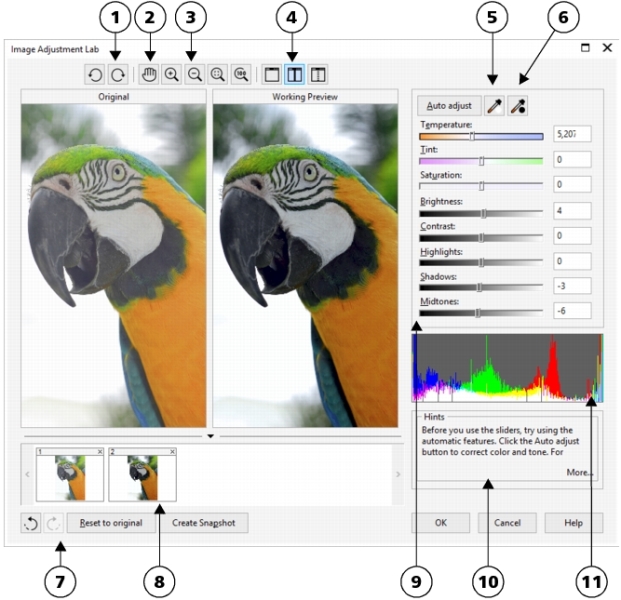

Here’s where you need a strategy with a little more finesse to correct the image. If your shadows are simply isolated instances, applying an adjustment filter to the entire image may correct the shadows, but it may ruin the lighting in the rest of the image. In this case, reducing the input clipping value of 255 (the default) by half was enough to bring the shadowy details into view. In the example below, light reflections are enough to cause overexposure of the entire image – including the main point of interest. Slightly reducing the upper limit of the Input Value Clipping range can lighten the overall image, including the shadowy areas. The tools in the dialog enable you to set the input and output ranges for the black and white limits of your image, or adjust the image’s gamma range, or both. To access this feature, choose Image > Adjust > Contrast Enhancement. Options in the Contrast Enhancement dialog (see below) enable you to adjust the gamma range of an image while adjusting the input contrast settings. With all three sliders in the dialog set at 40 percent, the areas of shadow in the previously dull image become more detailed, and the overall image is improved.ĭepending on the contrast qualities of your image, you can also play with gamma and contrast to reveal shadowy areas. In the water scene below, light from the bright sparkles created by sunlight reflections has caused underexposure of the main subject. The Brightness, Contrast, and Intensity sliders enable you to adjust these properties as percentages of the original values. You can control the sliders in the Brightness/Contrast/Intensity dialog (see below), which you open by choosing Image > Adjust > Brightness/Contrast/Intensity, or by using the Ctrl+B shortcut. One strategy for lightening the image is to use one of the adjustment filters in Corel PHOTO-PAINT. When bright light reflects off surfaces like snow or water, it can create highlights intense enough to cause the rest of the image to appear dull. Corel PHOTO-PAINT offers several methods to coax hidden details from the shadows. On the flip side, a brightly lit scene can include isolated shadows in unfortunate places, like under the brim of a hat or on the dark side of sun-drenched photo subjects. Isolated bright spots can cause overall darkness in an image. Different situations require different correction methods, depending on the intensity of the light source, or sources, in your photo and on the location of shadowed areas.
#Fade photos in corel draw 11 how to#
Since it’s often too difficult or time-consuming to restage what you originally photographed, the trick is in knowing how to correct the digital version.

Whether you are using a digital camera or scanning your photos, Corel PHOTO-PAINT® lets you to fix lighting problems after your image enters the digital realm. You can correct this unwelcome side effect several ways. Sunlight skews the averaging, causing underexposure. The internal light meter averages the values of the light and dark areas you see through the lens, and your camera’s internal program uses these values to set the exposure for the complete scene. The problem is often due to incorrect exposure caused by your camera’s automated features and extreme light levels entering the lens. The bright light and harsh shadows may hide the person, place, or thing you specifically want to capture. Sometimes, though, that sunshine can work against you. Whether you’re a professional, a tourist or just a weekend photo hobbyist, there’s nothing like taking a few pictures in the great outdoors on a bright, sunny day.


 0 kommentar(er)
0 kommentar(er)
